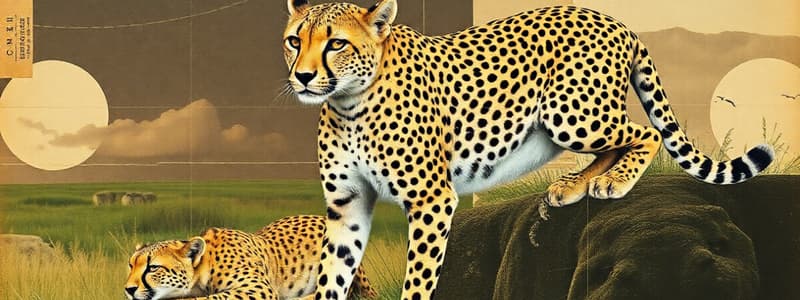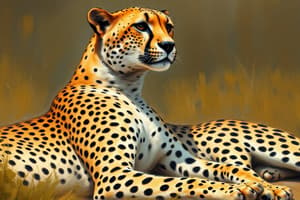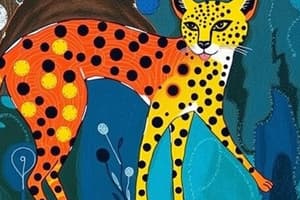Podcast
Questions and Answers
What fundamental characteristic defines a life cycle for all living organisms?
What fundamental characteristic defines a life cycle for all living organisms?
- Living in groups for protection and social interaction.
- A sequence of stages from birth, growth, to death. (correct)
- The ability to hunt and consume other animals.
- The capacity to adapt to different environments over time.
Why is it biologically significant that cheetah cubs are classified as mammals?
Why is it biologically significant that cheetah cubs are classified as mammals?
- Mammals are typically born in larger litters than other animal groups.
- Mammalian offspring are born alive and nourished by their mother's milk. (correct)
- Mammals are the only animals that exhibit parental care for extended periods.
- Mammals are known for their exceptional speed and hunting skills from birth.
Considering the typical litter size mentioned, which scenario would be considered unusual for cheetah births?
Considering the typical litter size mentioned, which scenario would be considered unusual for cheetah births?
- A cheetah mother giving birth to three cubs.
- A cheetah mother giving birth to five cubs.
- A cheetah mother giving birth to two cubs.
- A cheetah mother giving birth to six cubs. (correct)
What is the primary reason young cheetahs remain with their mothers for an extended period?
What is the primary reason young cheetahs remain with their mothers for an extended period?
Which of the following best describes the diet of a cheetah, based on their classification as carnivores?
Which of the following best describes the diet of a cheetah, based on their classification as carnivores?
What role do father cheetahs typically play in the upbringing and care of their cubs?
What role do father cheetahs typically play in the upbringing and care of their cubs?
How does the typical social structure of adult female cheetahs differ from that of adult male cheetahs?
How does the typical social structure of adult female cheetahs differ from that of adult male cheetahs?
If an adult cheetah measures 4 feet in length (excluding the tail), approximately what could be its total length including a typical tail?
If an adult cheetah measures 4 feet in length (excluding the tail), approximately what could be its total length including a typical tail?
What is the likely weight range for a fully grown adult cheetah, as described in the text?
What is the likely weight range for a fully grown adult cheetah, as described in the text?
Under which condition is a cheetah most likely to live longer than its typical lifespan in the wild?
Under which condition is a cheetah most likely to live longer than its typical lifespan in the wild?
Flashcards
Life Cycle
Life Cycle
The way a living thing is born, grows, and dies.
Cheetah Cub
Cheetah Cub
A young cheetah.
Den
Den
A safe place where a mother cheetah gives birth and raises her cubs.
Mammals
Mammals
Signup and view all the flashcards
Carnivores
Carnivores
Signup and view all the flashcards
Hunting
Hunting
Signup and view all the flashcards
Young Cheetah Development
Young Cheetah Development
Signup and view all the flashcards
Adult Cheetah
Adult Cheetah
Signup and view all the flashcards
Cheetah Lifespan
Cheetah Lifespan
Signup and view all the flashcards
Zoo or Wildlife Preserve
Zoo or Wildlife Preserve
Signup and view all the flashcards
Study Notes
Cheetah Life Cycle
- Cheetahs, like all living things, have a specific life cycle, which encompasses birth, growth, and death.
- Cheetahs are mammals, meaning they are born live, not from eggs.
- Cubs are born in safe areas within tall grass, typically in groups of three to five.
- Mothers provide milk and nurture their cubs.
Young Cheetahs
- Cubs stay with their mother for approximately 1.5 to 2 years.
- During this time, cubs learn hunting skills and play together within their den or home area.
- Cheetahs are carnivores, hunting and consuming other animals like antelope and deer.
- The mother cheetah primarily cares for the cubs, while the father is absent.
Adult Cheetahs
- By age two, cheetahs are fully grown and capable of independent survival.
- Adult female cheetahs typically live alone, while adult male cheetahs often live in groups of 2-3.
- Adult cheetahs are typically 3.5 to 4.5 feet long (excluding the tail), with tails potentially exceeding 2 feet in length.
- Adult cheetahs weigh between 70 and 150 pounds.
- In the wild, cheetahs typically live 10 to 12 years; captive cheetahs in zoos or preserves may live longer.
Studying That Suits You
Use AI to generate personalized quizzes and flashcards to suit your learning preferences.




